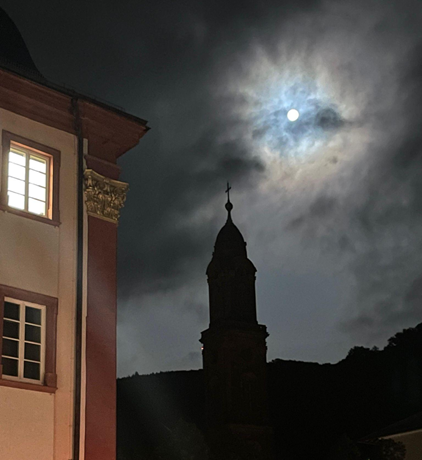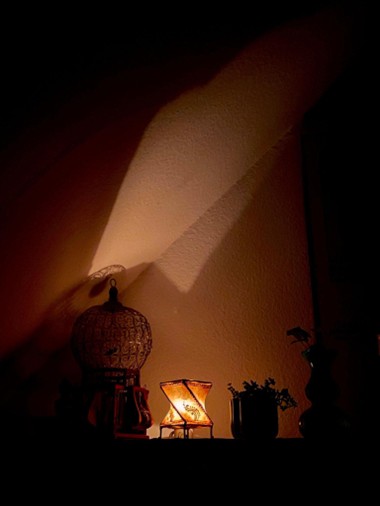#Labelling, #Normalization
Going up the stairs of Frankfurter Kunstverein, I was already led by the smell of garlic to the Mak Kimchi Workshop in the installation space of the artist couple La Caoba (Larry Bonćhaka and Sopo Kashakashvili). There were already about 10 participants gathering and chatting, with their containers to bring the kimchi home. I came to join alone, but I was relieved to find a friend and the guest host, Inah. The exhibition room had a greenhouse at the center, jute bags on the wall with signs of “TARIFFS”, “FREE WATER”, “DECOLONIZE FOOD”, and so on, wooden sticks and stones hung from the ceiling with ropes. The right front corner of the room was full of ingredients and cooking utensils. Every Saturday, the artists invite guests to participate in a cooking session that fosters transcontinental community-building. On the table were also Georgian spices from the previous session. In this transcultural and cross-media space, I recollected the memory of the fridge in my family home in Osaka, Japan, which was also always filled with the smell of kimchi.
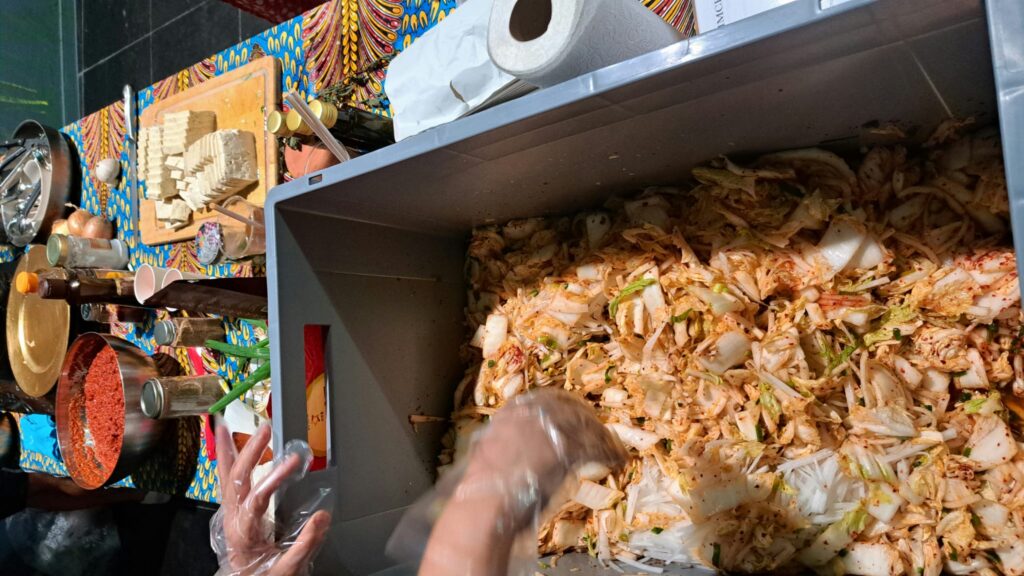
I remember this one day, when I was in elementary school, I had a friend come over. As soon as I opened the fridge to show her the drink options, she was surprised to find a container of homemade kimchi from my grandmother. To her surprise, I found out that home-made kimchi in the fridge was not ‘’normal’’ in my suburban neighborhood of Osaka. My grandmother would make kimchi with cabbage, radish, and cucumber, but my most favourite kimchi as a kid was with dried squid that my father would buy in Tsuruhashi district, a so-called “Korean town” located in the center of Osaka. Ever since this encounter, however, I have become hesitant to open the fridge in front of my friends.
My father was famous among my friends from kindergarten as a master of BBQ. While he made a fire in a Shichirin (small charcoal grill) in a workspace of his business which my grandfather built next to our house, I would go to our small garden, picked some lettuce that my grandmother grew, and helped my mother marinate the beef slices from a Korean butcher in Tsuruhashi with my father’s home-made BBQ sauce. We sometimes had steamed pork with Gochujang sauce on the same table, which I had recently learned is called Bossam. It was when my friend’s family came over to join the BBQ that I realized the red sauce would be too spicy for some of my friends.
For the longest time, I didn’t know that these dishes were Korean, which my friends’ families would not cook. A Korean couple was visiting us occasionally, and I remember my parents telling me to say “Hi”. One day, I asked my mother who they were and learned that they were my relatives.
It was only later that my mother told me, “Your father had a Korean passport, too, but he decided to be naturalized after we married,” which came as a shock, since for a decade of my life, I was thinking, “I am 100% Japanese.”
Why didn’t you tell me about that?
Because your grandmother was worried. In old times, there were discriminations against Korean people, and there might still be…
What she said immediately made me let go of the need to know why no one had told me about the Korean side of my family, and until I entered university, nothing had made me feel comfortable enough to tell my friends about the Korean background of my family.
My grandfather had moved to Japan alone when he was nineteen. He met my grandmother, whose parents are Korean, in Okayama and then settled in Osaka. My grandmother cannot speak Korean, but she might understand a few words from K-dramas. My grandfather, however, could, according to my father. I always wonder if he would have taught Korean to my father and me if discrimination did not exist. Now that I love traveling to South Korea and watching K-dramas, sometimes I wish I could understand the language. I am not saying that it was wrong of them not to teach me Korean. Me not being able to speak Korean is a result of their care to protect me at that time and a gift for me to trace back their thoughts as I do in this essay.
I did not inherit the Koreanness of my family by language, but by food. During the New Year (Osyōgatsu) season, which the biggest holiday when many people spend time with their families and eat traditional cuisines, a popular conversation topic around this time in Japan is what kind of Ozōni (a soup with sticky rice cake to be served during the New Year holidays in Japan) each family eats at home. Some people make it with miso, some without. Others cook it with bean paste, depending on the region of the families’ origins. Every family had their own way of cooking it, but I didn’t know what Ozōni was, and I could not understand why it was a hot topic among friends. This was when I realized my family traditions were not ‘’normal’’. I had never had Ozōni at home, but Tteokguk soup, a Korean soup with rice cake that is not as sticky as the Japanese ones. On the first day of January every year, we would place the dishes in front of our ancestors’ portraits, and bow to the floor for them before we started the holiday meal. This tradition, in Korea, is called Jesa, which would also be different from the Japanese way of celebrating New Year’s. Year by year, “What kind of Ozōni do you eat for New Year?’’ became an uncomfortable question to answer because of the abnormality. “If I tell my friends what we cook for New Year’s, they might find it weird”, I thought. I would just answer “miso,” which seemed to be the most common in my region.
Leading up to New Year’s, and as the end of December approaches, my aunts come to my family home to help my grandmother prepare Chijimi (Korean pancake with leek), tempura (how she called it in a Japanese word. In Korean, Yukjeon), Namul (marinated veggies), and kimchi. My mother would put a Hello Kitty apron on me and always take me to the kitchen first to help the ladies. I asked, “How come my little brother doesn’t help us? He is still sleeping!” She answered, “Just let him sleep because he is a boy.” As I grew up, I became more and more sensitive about this difference in the gender role that was expected of me. As I found my family tradition different from my friends’, I started growing a little jealous about not having a “normal Japanese” New Year’s dishes with Ozōni and Osechi, a collection of dishes in a lacquer box that can just be ordered.
It was only after I started living in Germany that I began to truly appreciate my grandmother’s homemade kimchi. Having tried all the European groceries that I cannot find in Japan and started missing Asian food, I remembered that there was always a red kimchi container in the fridge at home in Osaka. I can easily get kimchi at shops like Go Asia or Rewe, but somehow, they are not satisfying enough. Living apart from my family could have been a chance to have my own “normal Japanese” fridge, one that I wished for as a child, to avoid being “different.” However, unlike Japan, where many people have only Japanese relatives, everyone in Germany has a different background. Having Korean relatives as a Japanese person would not come as a surprise to anyone. In Frankfurt, there are many Korean supermarkets; because of the large number of Korean companies, trendy bubble tea shops, and cafés with matcha latte, which are full of locals. This environment might have helped me realize my true identity that cannot be described only with the labels of “Japanese” or “Korean”. Although I once wished to have “normal Japanese” traditions as a kid, what I missed at home in Germany was not just a fridge full of Japanese ingredients, but a fridge with kimchi, one that is filled with garlic smell and Korean New Year dishes.
Coming back to the workshop, it started with the introduction of the ingredients by the two guest hosts, a friend of mine from Heidelberg, Inah, and her friend Bora. They had already salted the cabbage in a huge bucket the day before. From their recipe, I thought it might be true that Korean cuisines in Japan have slightly been transformed over time. Watching them marinate cabbage with gloves and spread sesame oil in a pan, I felt like I was back home preparing New Year’s dishes with my aunties, mom, and grandma. I was grateful that the constellation of Korean recipes that was descended to me by women back home was reconnected to me in Germany through these women.
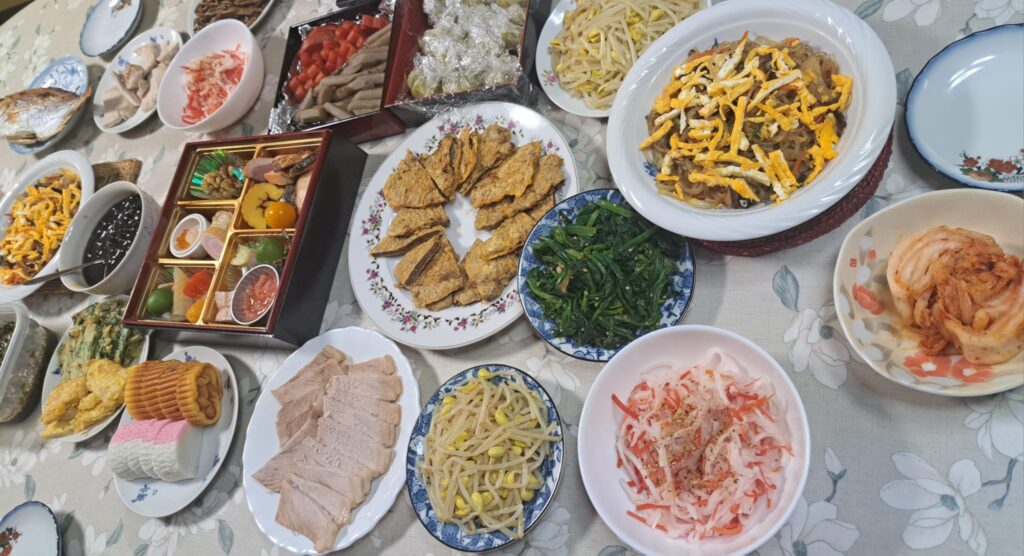
On the table were onions, green onions, fruits, sticky rice, sesame oil, seaweeds, and kilograms of Gochugaru (red pepper powder). As soon as I saw this table full of ingredients, I began thinking that how my grandmother makes kimchi might be simpler than how it is usually made in Korea. In Japan, some Zainichi (descendants of Koreans who forcibly or voluntarily migrated to Japan during WWII and Japan’s colonization of Korea from 1910 to 1945) restaurant owners or chefs on YouTube promote a “taste of Zainichi Korean” Because every Zainichi Korean has a different background and associations with Korea, I did not like how they automatically categorize my grandmother’s taste. I don’t even know if my grandparents on my father’s side should be categorized as “Zainichi” or if they want to be. My grandmother’s dishes have more gentle and milder flavors than the Korean dishes I eat outside of home. When I sent the photo of the table to my father. He replied, “Grandma doesn’t put in that many ingredients. It’s much easier!🙂.”
If I come to think about it, I didn’t know if my New Year’s dishes were really Korean style or my grandmother’s style. On January 1, 2025, I spent New Year’s holidays in my 19-square-meter apartment in Frankfurt. I found myself googling how to make Tteokguk and getting the rice cakes at Go Asia in Zeil at Hauptwache. I helped my grandmother cook some Korean dishes for the New Year, but I had never helped her make Tteokguk. She would start by making chicken broth, and put egg, rice cakes, tofu, and when serving, add seaweeds and soy sauce with green onions. For some reason, I could not find the recipe with chicken. I just made it with beef as the recipe written by the Korean poster, because I was not sure if Korean people really eat this soup for the New Year, anyway. After a week, I met a Korean friend who showed me a photo of Tteokguk that she had made. It was the first proof I had that Tteokguk is really made outside my family. Interestingly, she had never heard of a Tteokguk with chicken. Again, I wondered whether my grandmother’s recipes differ from what is eaten in Korea today.
When I cook what my grandmother cooked, I feel like I am decolonizing all the background history, which eventually prevented me from speaking about my family tradition with pride. If it was because of the discrimination against Koreans and Zainichi Korean people, which made my grandparents obscure their Korean identities, my act of learning Korean culture is for me, the act of recovering the unspoken part of my family history. What I can do is try to reassemble the Korean culture that my grandparents might have passed down to my family if they had not been pressured to conceal their identities.
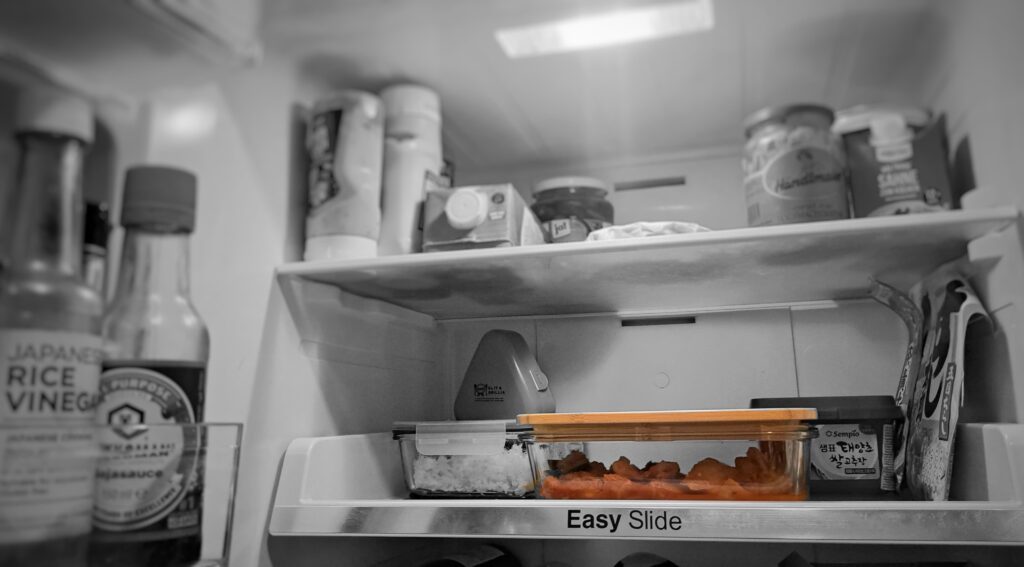
After the workshop, the entire gallery smelled of kimchi, from the basement to the third floor. When leaving the building, I felt proud that it was filled with the comforting smell of my family’s fridge. Of course, after the workshop, the fridge in my apartment in Frankfurt smelled of garlic like my family’s fridge, and I felt a sense of pride in my homemade kimchi.



